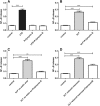Dietary N-Glycans from Bovine Lactoferrin and TLR Modulation
- PMID: 28971586
- PMCID: PMC6120133
- DOI: 10.1002/mnfr.201700389
Dietary N-Glycans from Bovine Lactoferrin and TLR Modulation
Abstract
Scope: Bovine lactoferrin (bLF) is an ingredient of food supplements and infant formulas given its antimicrobial and antiviral properties. We modified bLF enzymatically to alter its N-glycosylation and to isolate the glycan chains. The aims of this study include (1) to evaluate whether such derivates induce responses via pattern recognition receptors namely Toll-like receptors (TLRs) and (2) to relate those responses to their different glycosylation profiles.
Methods and results: The unmodified and modified bLF fractions are incubated with reporter cell lines expressing pattern recognition receptors. Afterwards, we screen for TLRs and analyze for nuclear factor kappa-light-chain enhancer of activated B cells (NF-κB) activation. Activation of reporter cell lines show that signaling is highly dependent on TLRs. The activation pattern of bLF is reduced with the desialylated form and increased with the demannosylated form. In reporter cells for TLR, bLF activate TLR-4 and inhibit TLR-3. The isolated glycans from bLF inhibit TLR-8. TLR-2, TLR-5, TLR-7, and TLR-9 are not significantly altered.
Conclusion: The profile of glycosylation is key for the biological activity of bLF. By understanding how this affects the human defense responses, the bLF glycan profile can be modified to enhance its immunomodulatory effects when used as a dietary ingredient.
Keywords: N-glycosylation; NF-κB; bovine lactoferrin; toll-like receptors.
© 2017 WILEY-VCH Verlag GmbH & Co. KGaA, Weinheim.
Figures







Similar articles
-
Inhibitory Effects of Dietary N-Glycans From Bovine Lactoferrin on Toll-Like Receptor 8; Comparing Efficacy With Chloroquine.Front Immunol. 2020 May 12;11:790. doi: 10.3389/fimmu.2020.00790. eCollection 2020. Front Immunol. 2020. PMID: 32477333 Free PMC article.
-
Bovine lactoferrin counteracts Toll-like receptor mediated activation signals in antigen presenting cells.PLoS One. 2011;6(7):e22504. doi: 10.1371/journal.pone.0022504. Epub 2011 Jul 25. PLoS One. 2011. PMID: 21799877 Free PMC article.
-
Characterization of recombinant human lactoferrin N-glycans expressed in the milk of transgenic cows.PLoS One. 2017 Feb 7;12(2):e0171477. doi: 10.1371/journal.pone.0171477. eCollection 2017. PLoS One. 2017. PMID: 28170415 Free PMC article.
-
The Multifaceted Roles of Bovine Lactoferrin: Molecular Structure, Isolation Methods, Analytical Characteristics, and Biological Properties.J Agric Food Chem. 2023 Dec 27;71(51):20500-20531. doi: 10.1021/acs.jafc.3c06887. Epub 2023 Dec 13. J Agric Food Chem. 2023. PMID: 38091520 Free PMC article. Review.
-
Toll-like receptors signaling: A complex network for NF-κB activation in B-cell lymphoid malignancies.Semin Cancer Biol. 2016 Aug;39:15-25. doi: 10.1016/j.semcancer.2016.07.001. Epub 2016 Jul 9. Semin Cancer Biol. 2016. PMID: 27402288 Review.
Cited by
-
An overview on in vitro and in vivo antiviral activity of lactoferrin: its efficacy against SARS-CoV-2 infection.Biometals. 2023 Jun;36(3):417-436. doi: 10.1007/s10534-022-00427-z. Epub 2022 Aug 3. Biometals. 2023. PMID: 35920949 Free PMC article. Review.
-
Natural resources to control COVID-19: could lactoferrin amend SARS-CoV-2 infectivity?PeerJ. 2021 Apr 14;9:e11303. doi: 10.7717/peerj.11303. eCollection 2021. PeerJ. 2021. PMID: 33954061 Free PMC article.
-
Casein Lactose-Glycation of the Maillard-Type Attenuates the Anti-Inflammatory Potential of Casein Hydrolysate to IEC-6 Cells with Lipopolysaccharide Stimulation.Nutrients. 2022 Nov 29;14(23):5067. doi: 10.3390/nu14235067. Nutrients. 2022. PMID: 36501097 Free PMC article.
-
Lactoferrin: A Glycoprotein Involved in Immunomodulation, Anticancer, and Antimicrobial Processes.Molecules. 2021 Jan 3;26(1):205. doi: 10.3390/molecules26010205. Molecules. 2021. PMID: 33401580 Free PMC article. Review.
-
HSV-1 immune escapes in microglia by down-regulating GM130 to inhibit TLR3-mediated innate immune responses.Virol J. 2024 Sep 16;21(1):219. doi: 10.1186/s12985-024-02492-x. Virol J. 2024. PMID: 39285274 Free PMC article.
References
-
- Satue‐Gracia M. T., Frankel E. N., Rangavajhyala N., German J. B., J. Agric. Food Chem. 2000, 48, 4984. - PubMed
-
- Aly E., Ros G., Frontela C., J. Food Res. 2013, 2, 25.
-
- Buccigrossi V., De Marco G., Bruzzese E., Ombrato L., Bracale I., Polito G., Guarino A., Pediatr. Res. 2007, 61, 410. - PubMed
-
- Liao Y. L., Jiang R. L., Lonnerdal B., Biochem. Cell Biol. Biol. Cell. 2012, 90, 476. - PubMed
-
- Steijns J. M., Int. J. Dairy Technol. 2001, 54, 81.
Publication types
MeSH terms
Substances
LinkOut - more resources
Full Text Sources
Other Literature Sources
Miscellaneous

